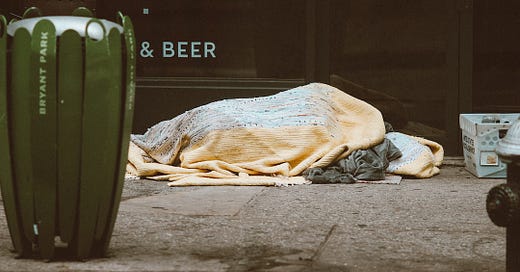We Must Address Poverty
How has poverty been ingrained into the system we live in, and why haven't we solved this issue?
Poverty is a cause of inequality between people within a nations, and nations themselves, dividing society, and resulting in an accumulation of power. The inherent selfishness which is a key part of our preservation mechanism is detrimental to society as a whole in the modern world, when it prevents the elites from acting in the interests of the community, rather than pursuing growth for their firm or country - leading to both societal and environmental consequences. In 2022, in 111 developing countries, there were 1.2 billion people living in acute multidimensional poverty. It is a duty, not a choice, to tackle this issue.
The first United Nations Sustainable Development Goal is to ‘end poverty in all its forms everywhere’, but solving the issue of poverty will also contribute to almost all of the other goals, including that of reducing hunger and inequality, and promoting sustainability. Poverty is a cause of inequality between people within a nations, and nations themselves, dividing society, and resulting in an accumulation of power. The star charts in nursery schools, grades in college, and benefits in the workplace have conditioned us into believing that those who work the hardest get the rewards. But it does not consider the starting places, and access to basic resources of the people in this competition. What if the child wasn’t in the nursery in the first place? Or the teenager was busy working, so couldn’t revise for the test? Or a person lives in a country where access to clean water is their primary concern, rather than networking at that business meeting? The inherent selfishness which is a key part of our preservation mechanism is detrimental to society as a whole in the modern world, when it prevents the elites from acting in the interests of the community, rather than pursuing growth for their firm or country - leading to both societal and environmental consequences.
The former national security advisor of the USA, Rostow, claimed that underdeveloped countries must focus on moving away from trade and money-lending, towards industry, and modernise agricultural techniques - with fiscal and monetary policies aimed in this direction. However, as Kuznets (American Nobel Winning Economist) claimed, the GDP per capita of now developed countries, when they were developing, was significantly higher than that of currently underdeveloped countries, meaning that they are either ‘at some earlier stage within the long-term trend of the presently developed countries’, or (more probably) ‘at some stage in a sequence of long-term growth separate and distinct from that of the Western European cradle’. Furthermore, underdeveloped countries nowadays are in a relatively inferior position compared to other countries, whereas industrialisation saw a rise in countries which were already dominating the world.
Clearly, industrialisation is not the answer. The focus on consumption and growth amongst the upper and middle classes in the West shows complete neglect of their responsibility to the rest of the world and its future. Covid-19 has seriously exacerbated these issues, as shown in a report by Oxfam, which states that due to the pandemic, the 10 richest men have seen a double in their wealth, whereas 99% of the global population saw a drop in their (real) incomes. The United Nations has created a measure of poverty which is aimed at solving the problem, (as opposed to simply providing figures which serve as an accessory to GDP figures for nations) called the Multidimensional Poverty Index. The MPI considers 3 main dimensions of poverty; health, education, and standard of living, with subcategories within them. The subcategories are assigned different ratings, and if somebody is considered deprived in a third, or more, of the indicators, they are ‘MPI poor’. The MPI is essential to tackling poverty, as it provides a comparable measure of poverty between different groups or nations, but moreover, it can be used to identify ‘deprivation bundles’ (recurring patterns of poverty), and the ‘poverty profiles’ of different communities, allowing valuable resources spent on aid to be aimed specifically to address individual issues where they occur.
In 2022, in 111 developing countries, there were 1.2 billion people living in acute multidimensional poverty. If we are to get anywhere near reaching the Sustainable Development Goals, or leaving the world in a better state than we found it, we must use the valuable data generated by the United Nations in MPI reports to purposefully allocate resources, and reframe our mindsets (and education systems) towards equality and sustainability, rather than the self defeating objective of increasing consumption.
Bibliography:
https://hdr.undp.org/content/2022-global-multidimensional-poverty-index-mpi#/indicies/MPI
https://unstats.un.org/sdgs/report/2022/The-Sustainable-Development-Goals-Report-2022.pdf



What do you think it will take to finally address poverty? Do you think the current methods used by the United Nations are enough to reduce inequality and bring about a sustainable future? Share your thoughts below!